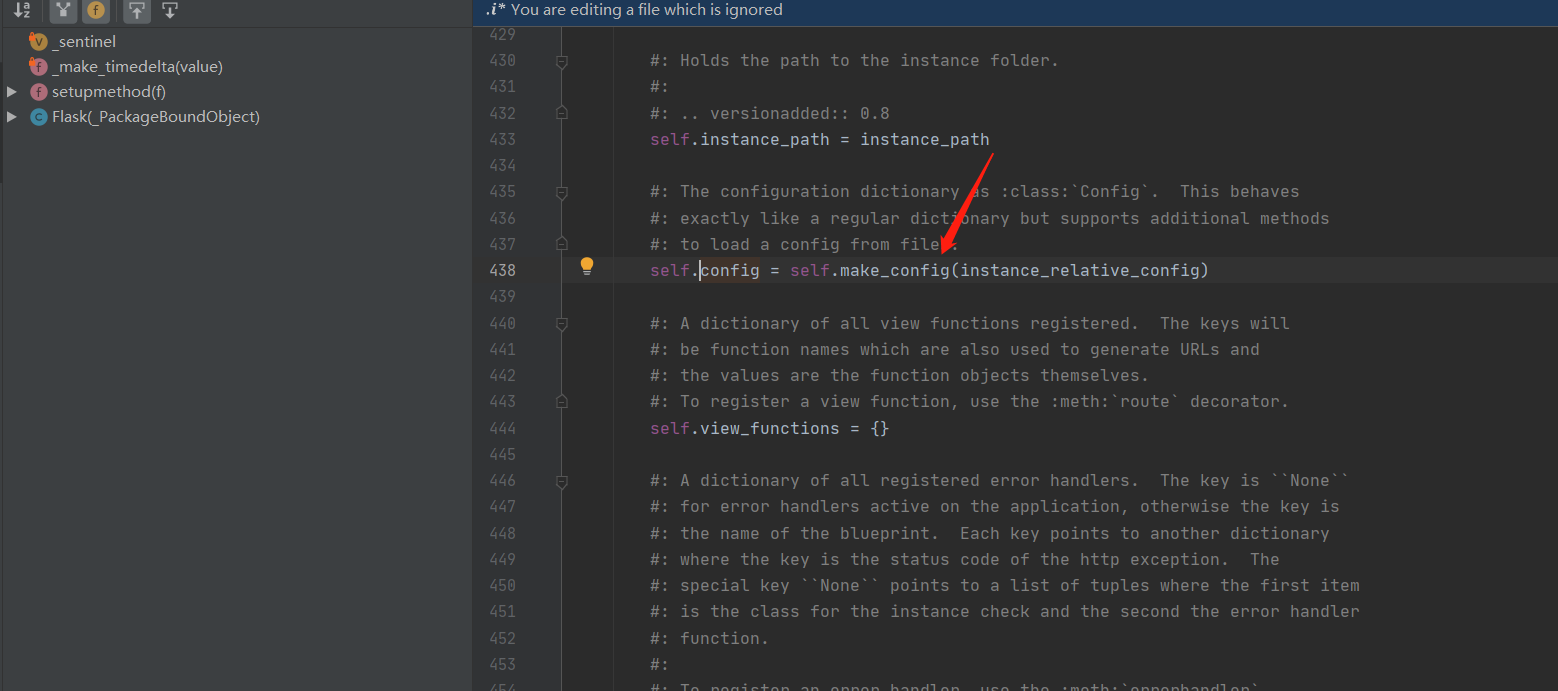引入 1 2 3 4 5 6 7 8 9 10 11 12 13 14 15 16 17 18 from flask import Flask, jsonifyflask_app = Flask(__name__) flask_app.config.from_mapping( { "SECRET_KEY" : "you never know the secret key" } ) @flask_app.route('/', endpoint="11", methods=["GET", "POST"]) def hello_world () : return jsonify(code=0 , msg="success" ) if __name__ == '__main__' : flask_app.run()
原理
Flask实例的config属性是Config对象Config类实现了from_mapping等方法
实现 config属性
看来Config对象是make_config方法返回的
1 2 3 4 5 6 7 8 9 10 11 12 13 14 15 16 def make_config (self, instance_relative=False) : """Used to create the config attribute by the Flask constructor. The `instance_relative` parameter is passed in from the constructor of Flask (there named `instance_relative_config`) and indicates if the config should be relative to the instance path or the root path of the application. .. versionadded:: 0.8 """ root_path = self.root_path if instance_relative: root_path = self.instance_path defaults = dict(self.default_config) defaults["ENV" ] = get_env() defaults["DEBUG" ] = get_debug_flag() return self.config_class(root_path, defaults)
我们看到了config类,就是self.config_class
这里暂停一下看 instance_relative,这个为true的话,会把 instance_path也就是你的Flask对象的路径,传给config_class类,毕竟如果你要从配置文件加载配置,我得知道文件路径在哪里,flask允许你根据Flask实例的相对路径来定位
默认是false,那就是应用的根目录绝对路径
Config类的定义
原来是继承自dict
再看from_mapping方法,我去掉了一些
1 2 3 4 5 6 7 8 def from_mapping (self, *mapping, **kwargs) : mappings = [] mappings.append(kwargs.items()) for mapping in mappings: for (key, value) in mapping: if key.isupper(): self[key] = value return True
大概逻辑就是把传入的字典放进list种
然后遍历每个字典,把字典的key作为Config的属性名,value作为属性值
如何读取 1 2 3 4 5 6 7 8 9 10 11 12 13 14 15 16 17 18 19 20 from flask import Flask, jsonify, current_appflask_app = Flask(__name__) flask_app.config.from_mapping( { "SECRET_KEY" : "you never know the secret key" } ) @flask_app.route('/', endpoint="11", methods=["GET", "POST"]) def hello_world () : sk = current_app.config["SECRET_KEY" ] return jsonify(code=0 , msg="success" ,data={"sk" :sk}) if __name__ == '__main__' : flask_app.run()
记住,current_app是代理对象,代理的是LocalStack种的Flask实例,这个栈一般在请求来的时候才会被push
所以你无法在视图函数外面写
1 current_app.config["SECRET_KEY" ]
因为此时从栈中 top出来的是None,None怎么又config属性呢
自定义配置方法 例如你的写java的leader要你从yaml中读取配置,你能怎么办呢?
首先 fuck一声
然后这么写,其实只需要给Config一个from_yaml方法就行了,但是我们不能改这个类,怎么办呢?
动态添加呗
1 2 3 4 5 6 7 8 9 10 11 12 13 14 15 16 def from_yaml (self, filename, silent=False) : filename = os.path.join(self.root_path, filename) try : with open(filename) as yaml_file: obj = yaml.load(yaml_file.read(), Loader=yaml.FullLoader) except IOError as e: if silent: return False return self.from_mapping(obj) app.config.from_yaml = types.MethodType(from_yaml, app.config) app.config.from_yaml("config.yaml" )
然后你把config.yaml文件放到flask实例下面就好了
如果你的老板突然又怀念java的 properties
那你怎么写呢?
1 2 3 4 5 6 7 8 9 10 11 12 13 14 15 16 17 def from_properties (self, filename, silent=False, encode=None) : filename = os.path.join(self.root_path, filename) try : with open(filename) as properties_file: obj = {} for line in properties_file: if line.find('=' ) > 0 : s = line.replace('\n' , '' ).split("=" ) obj[s[0 ]] = s[1 ] except IOError as e: if silent: return False return self.from_mapping(obj) app.config.from_properties = types.MethodType(from_properties, app.config) app.config.from_properties("config.properties" ) app.run()
这个工作起码要写两天,谁叫这个leader这么事儿多
我们看到在python中给实例动态添加方法和动态添加属性有点不同
动态添加属性简单
1 2 3 4 app.config.new_property="asdfa" 或者 setattr(app.config,"new_property" ,"asdf" ) 这种根据字符串找到对象属性的做法又叫反射
但是给对象动态添加方法就不同了,要用到 types.MethodType
1 app.config.from_properties = types.MethodType(from_properties, app.config)
我们甚至还可以这样给类动态添加方法,只要把你的app.config换成类就行了
当然,你也可以动态删除一个对象的属性
1 2 del 对象.属性名delattr(对象, “属性名”)

